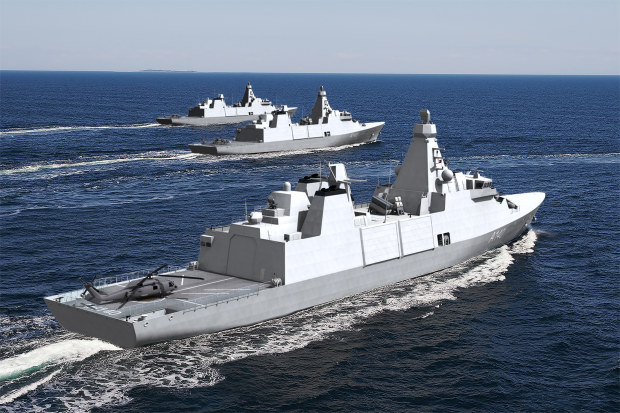Australia and New Zealand could team up on building a new fleet of light frigates, with British shipbuilding giant Babcock pitching the proposal for its Arrowhead frigate to Defence amid a major naval review.
The Australian Financial Review has been told Kiwi naval chiefs have spoken with Australian counterparts about their interest in working together on a joint replacement for ageing ANZAC-class frigates.

Artists’ rendering of Babcock’s Arrowhead frigate.
A potential tie up would replicate the deal that delivered the German-designed ANZACs, under which 10 3600-tonne ships were built in Australia in the 1990s and early 2000s, with eight delivered to the Royal Australian Navy and two to New Zealand.
Babcock’s confirmation it has put forward its Arrowhead design to the Defence Department comes amid jockeying among shipbuilders to influence the Albanese government’s surface fleet review.
The review, which originated from the Defence Strategic Review, is due to hand its findings to the government next month on the long-term composition of the navy’s warship fleet in light of the decision to acquire nuclear-powered submarines.
It says the navy should have “a larger number of smaller surface vessels”, which has put the troubled $45 billion Hunter-class frigates in the frame for cuts.
Current plans call for nine of Britain’s BAE Systems’ anti-submarine warfare frigates, which are nearing 10,000 tonnes in weight, but there is widespread industry expectation the number could be reduced to six or even as few as three to free up cash for smaller warships or additional destroyers.
German shipbuilder Luerssen is also building 12 patrol boats for the navy, but there is speculation that order could be halted at six. Luerssen has proposed building corvettes instead, which would be fitted with missiles.
READ MORE
- With China in sights, New Zealand signals major defense policy shift
- Australia to take key role in NZDF capability growth
- New Zealand unveils defense strategy documents. Here’s what they say.
- Is NZ gearing up for war? Newshub Nation's Laura Walters quizzes Andrew Little on major new defence strategy
Spanish shipbuilder Navantia has also offered corvettes, as well as additional air warfare destroyers, while another German shipbuilder, TKMS, has also signalled interest in bidding for corvettes.
But industry sources say Babcock’s light frigate is gaining traction with elements of the navy. Larger than a corvette at 5700 tonnes, this offers it a longer range – important for operations in the South China Sea or Indian and Pacific oceans – as well as the ability to carry more missiles.
One source said the Kiwi navy had told Australian officials that if the Albanese government went down the path of selecting a light frigate such as the Arrowhead, New Zealand would be keen to partner.
New Zealand’s own defence strategy paper, issued last week, highlighted the need to maximise opportunities with Australia and that the Five Eyes alliance – Australia, New Zealand, the US, Canada and Britain – would be a key supplier of defence technology.
“We know the frigates are coming to the end of their life and replacement decisions will need to be made in the next few years,” New Zealand Defence Minister Andrew Little said.
Babcock has briefed Defence Department officials about its proposal for the frigate, which is also under construction for the UK navy as the Type 31.
Babcock Australasia chief executive Andrew Cridland said the Arrowhead was capable of conducting a variety of missions including strike operations in blue water and littoral areas.
“We consider the Arrowhead would deliver significant capability to the Royal Australian Navy and meet naval requirements both now and into the future,” he said.
“To be delivered as a truly sovereign solution, an Australian Arrowhead would be built in-country, providing a significant boost for jobs, industry and the economy, and playing a key role in Australia’s continuous shipbuilding agenda.
“Capable of operating with a core crew of only 100 people, Babcock’s Arrowhead frigate would allow the Royal Australian Navy to deploy more capability with a significantly smaller crew.”
The risk of diplomatic fallout from Britain by reducing the number of British-designed Hunter-class frigates would also be mitigated by selecting Babcock. And BAE Systems already stands to be rewarded handsomely under the AUKUS nuclear-submarine pact.





